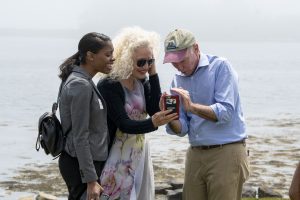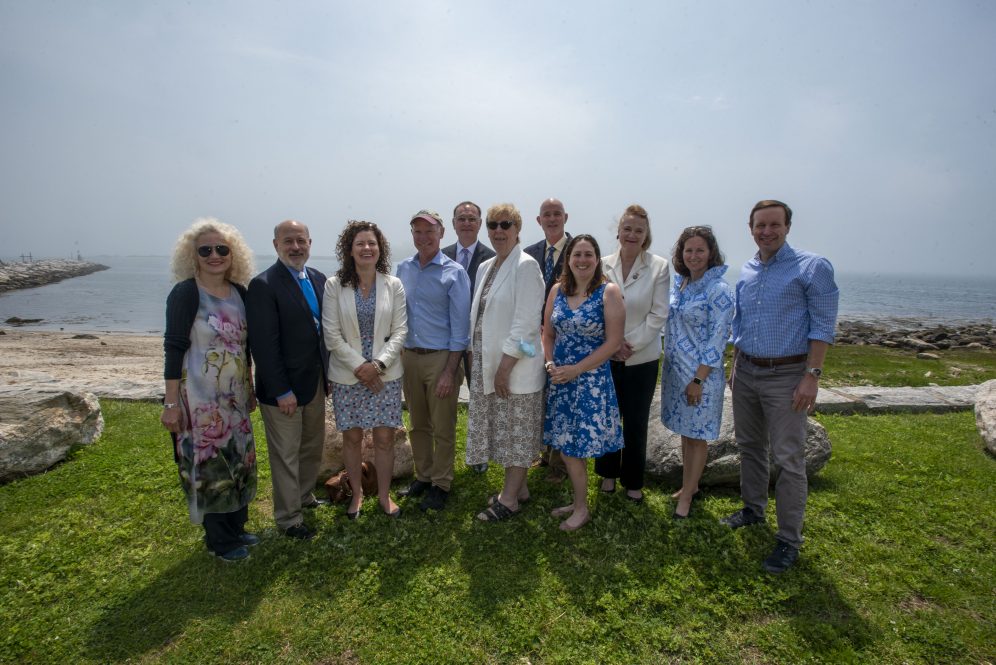As the fog gave way to sunshine amid shoreline breezes, a large group of UConn leaders and researchers, state and federal officials, environmental group representatives, and others gathered Saturday at Avery Point to celebrate the designation of the Connecticut Natural Estuarian Research Reserve.
The reserve comprises 52,160 acres of Long Island Sound, adjacent marshes, and upland areas, all of which provide bountiful opportunities for research, environmental sustainability, public involvement.
The National Oceanic and Atmospheric Administration (NOAA) officially designated the area in January as the 30th such reserve in the country. It includes the lower Connecticut and Thames Rivers and several islands, state parks, and UConn Avery Point in Groton, which will serve as the central location for the estuary’s administration, research activities, and education offices.
Estuaries are rich areas of brackish water and surrounding wetlands where freshwater meets the sea. Their waters are saltier than freshwater rivers but less so than the ocean, and the resulting ecosystem of life is unique. The Connecticut shoreline estuary now becomes part of the NERR network of coastal sites designated to protect and study estuarine systems.
“This unique program – built on state/federal partnerships like you’re seeing here today — has really made great strides in our national efforts to address particularly complicated issues associated with climate change, but also increasing equitable access to the beauty and benefits of these important coastal areas,” NOAA Administrator Rick Spinrad, Ph.D., said at Saturday’s event.

“The reserve system is going to enable us to invest in sustained long-term trusted relationships so that we can better understand community needs. It’s going to allow us to use that understanding to get relevant information into the hands of decision makers at every level: local communities, state industry, nongovernmental organizations,” he added.
“It’s also going to address inequalities in order to allow access to outdoor recreation and educational opportunities, and we will develop new products and services that will improve on our existing capabilities to support climate readiness, response, and resilience.”
Scores of participants in Saturday’s event boarded a Project Oceanology research vessel at the campus after the ceremony, getting a firsthand look at some of the areas of the estuary.
UConn and several other public and private partners in Connecticut worked with NOAA to establish a reserve in the state. Connecticut Sea Grant and UConn’s Department of Marine Sciences have been instrumental in efforts on behalf of UConn, along with Connecticut DEEP, the Connecticut Audubon Society and The Pew Charitable Trusts.
“The timing of this designation could really not be better,” U.S. Rep. Joe Courtney said Saturday at the event, noting that millions of dollars are allocated in the new federal infrastructure bill for Long Island Sound, in addition to millions in recurring money for cleanup and other initiatives.
“There’s just this really great convergence of effort and in designation is going to be the leader in terms of the headlights as far as how we get to the end game of making this a much more thriving and sustainable body of water,” Courtney said.
The reserve will continue to encourage public involvement in all aspects of programming through outreach programs, volunteer opportunities, and invitations to advisory committees.
Designation as a NERR does not fundamentally change access or use of the reserve, but ensures these special places are properly cared for by leveraging the existing rules in place for state parks, preserves, and waters of Connecticut.
In this fashion, people can still access public beaches and hike through areas such as Bluff Point State Park, as well as boat, fish, and shellfish in the waters along the coastline and the mouths of the rivers – all while benefiting from the long-term values these sites provide for environmental research, education, and coastal resiliency.
“As storms continue to ravage this earth, this country, and this shoreline, we need to be reminded that it’s these coastal wetlands and coastal estuaries that provide us with over $20 billion of protection every single year — meaning if they weren’t here, we would have $20 billion in additional cleanup and reconstruction to do,” U.S. Sen. Chris Murphy told the audience at Saturday’s event.
“This is a moment in time where doing the hard work of stewardship is more important than ever, and the funding that we’re going get to be able to assist in these efforts is going to be critical,” he added.
For the estuary, NOAA will provide federal funds and Connecticut will match with state resources to support staff, research, and conservation. UConn and its partners will also coordinate educational and volunteer opportunities and share resources and research with other NERRs.
A recent study commissioned by NOAA and Pew found the work done at estuaries has economic benefits in addition to the environmental, research, and educational benefits they offer their communities.
In its review of four of the 19 NERR sites that existed in 2021, the study conservatively estimated that together, they generate more than $165 million in annual revenue for their communities, including $56.4 million in wages paid for at least 1,762 jobs.
For instance, they can protect economically important habitats and ecosystems that are key to certain industries, which is of particular importance in Connecticut given the value of the shellfish industry that operates along the shoreline and elsewhere in the region.
The NERR will also offer great educational benefit for UConn and school systems throughout the shoreline because the reserve will be a living laboratory for marine science activities. It will provide opportunities for students and researchers to get their hands and feet in the water and salt marshes as they learn about critical habitats for birds, fish, and other types of marine life.
“The reserve will offer our students in marine science, biology, agriculture, engineering, and faculty a protect environment to conduct research and explore across a variety of disciplines. For the people of our state and region, it’s also ensured the special environment is properly cared for preserved not only for our benefit, but for the benefit of future generations,” UConn Interim President Radenka Maric said Saturday.
—
Connecticut Sea Grant explores parks, islands, and more of the places within the reserve in Wrack Lines magazine. The in-depth articles can be found in the issue here.



